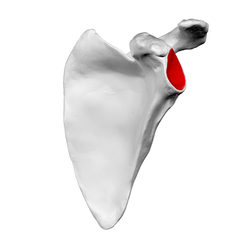Glenoid cavity
| Glenoid cavity | |
|---|---|

Costal surface of left scapula. Glenoid cavity shown in red.
|
|

|
|
| Details | |
| Identifiers | |
| Latin | cavitas glenoidalis, fossa glenoidalis |
| TA | A02.4.01.019 |
| FMA | 23275 |
|
Anatomical terms of bone
[]
|
|
The glenoid cavity or glenoid fossa of scapula is a part of the shoulder. It is a shallow , articular surface, which is located on the lateral angle of the scapula. It is directed laterally and forward and articulates with the head of the humerus; it is broader below than above and its vertical diameter is the longest.
This cavity forms the glenohumeral joint along with the humerus. This type of joint is classified as a synovial, ball and socket joint. The humerus is held in place within the glenoid cavity by means of the long head of the bicep tendon. This tendon originates on the superior margin of the glenoid cavity and loops over the shoulder, bracing humerus against the cavity. The rotator cuff also reinforces this joint more specifically with the supraspinatus tendon to hold the head of the humerus in the glenoid cavity.
The cavity surface is covered with cartilage in the fresh state; and its margins, slightly raised, give attachment to a fibrocartilaginous structure, the glenoid labrum, which deepens the cavity. This cartilage is very susceptible to tearing. When torn, it is most commonly known as a SLAP lesion which is generally caused by repetitive shoulder movements.
Compared to the acetabulum (at the hip-joint) the glenoid cavity is relatively shallow. This makes the shoulder joint prone to dislocation (luxation). Strong glenohumeral ligaments and muscles prevents dislocation in most cases.
...
Wikipedia
